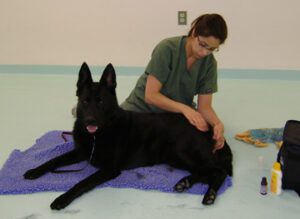This is the final article of our four-part alternative medicine series, which also includes acupuncture, laser therapy and Chinese herbs. These treatments will not appeal to all of our clients but we think it is important to provide them as options.
I always laugh at the range of reactions seen after a client is told there is a canine massage therapist on staff. The reactions vary from the positive “Wow, that’s great!” to the incredulous “Seriously?” to “What will they think of next?” While to some people pet massage may seem like a frivolous concept, it has been proven to have so many physical and psychological benefits that many professionals think it should be considered a regular part of a pet’s health care regimen.
 The benefits to massage are extensive. It increases circulation to all areas of the body, distributing oxygen and nutrients and enabling the body to work more efficiently, and actually heal faster when injured. It removes toxins and waste products that build up in the tissues. It softens the connective tissues that permeate the body, relaxing the muscles and improving organ function. It breaks the pain-tension cycle, which in turn helps prevent muscle strain and aches. Massage increases flexibility and joint mobility which is crucial to geriatric comfort—it’s always a pleasure to hear clients tell me how much more active their senior dogs are after a few massages! It also promotes better muscular balance throughout the body, resulting in effective support for other healing modalities.
The benefits to massage are extensive. It increases circulation to all areas of the body, distributing oxygen and nutrients and enabling the body to work more efficiently, and actually heal faster when injured. It removes toxins and waste products that build up in the tissues. It softens the connective tissues that permeate the body, relaxing the muscles and improving organ function. It breaks the pain-tension cycle, which in turn helps prevent muscle strain and aches. Massage increases flexibility and joint mobility which is crucial to geriatric comfort—it’s always a pleasure to hear clients tell me how much more active their senior dogs are after a few massages! It also promotes better muscular balance throughout the body, resulting in effective support for other healing modalities.
 Eli Caddell—a 10-year-old male German shepherd with hip dysplasia, arthritic elbows, and recent ataxia (lack of muscle coordination) in his rear limbs—is a frequent patient for acupuncture and recently received a chiropractic adjustment over his hips and sacrum. To help Eli maintain his adjustment, I gave him a massage that focused on relaxing the muscles of his hindquarters (especially his gluteals) and lower back. By using light hacking techniques, compressions to increase blood flow, and effleurage to help decrease inflammation from his adjustment, his muscles became softer and he was seen to visibly relax his facial expression. Because his shoulders and neck have been working overtime to compensate for his weak rear-end, the muscles were tight, and several knots were found in his left shoulder. I applied a hot pack to soothe the overworked muscles, applied calendula oil (a natural anti-inflammatory agent) on the knots, and using gentle kneading and effleurage, was able to work the kinks out. To balance him, I completed the massage by using petrissage/effleurage over head, neck, front limbs, chest, back, rump and hind limbs.
Eli Caddell—a 10-year-old male German shepherd with hip dysplasia, arthritic elbows, and recent ataxia (lack of muscle coordination) in his rear limbs—is a frequent patient for acupuncture and recently received a chiropractic adjustment over his hips and sacrum. To help Eli maintain his adjustment, I gave him a massage that focused on relaxing the muscles of his hindquarters (especially his gluteals) and lower back. By using light hacking techniques, compressions to increase blood flow, and effleurage to help decrease inflammation from his adjustment, his muscles became softer and he was seen to visibly relax his facial expression. Because his shoulders and neck have been working overtime to compensate for his weak rear-end, the muscles were tight, and several knots were found in his left shoulder. I applied a hot pack to soothe the overworked muscles, applied calendula oil (a natural anti-inflammatory agent) on the knots, and using gentle kneading and effleurage, was able to work the kinks out. To balance him, I completed the massage by using petrissage/effleurage over head, neck, front limbs, chest, back, rump and hind limbs.
Massage is a wonderful adjunctive therapy to acupuncture and chiropractic work because it can calm the animal, relieving muscle tension and warming the soft muscles, making the joints more pliable which allows for easier, more comfortable needle insertion and adjustments. It is beneficial after acupuncture and chiropractic adjustments in that it leaves the animal with significantly less muscle tension and spasm—tension that might otherwise pull the joints out of alignment again. When planning your pet’s holistic therapies, chiropractors and massage therapists generally agree that adjustments and massage should be scheduled as closely together as possible.
—Stephanie Kiszka, BS, LVT, CVMRT

